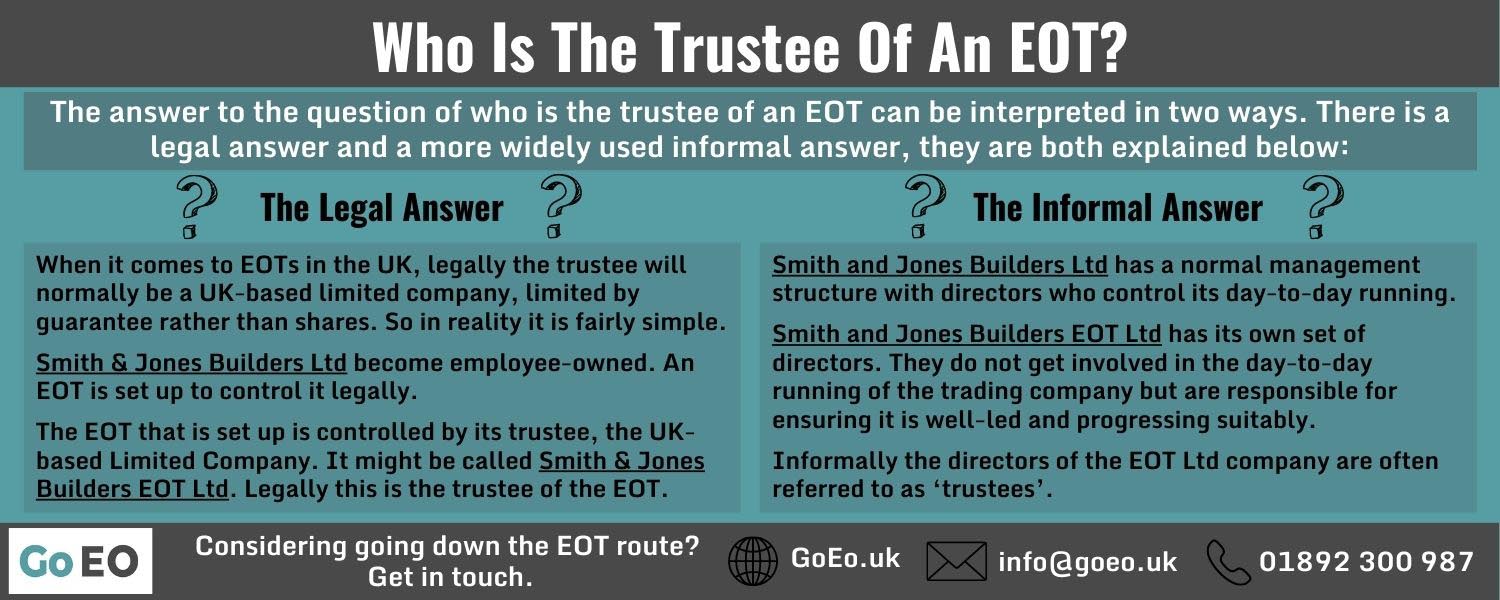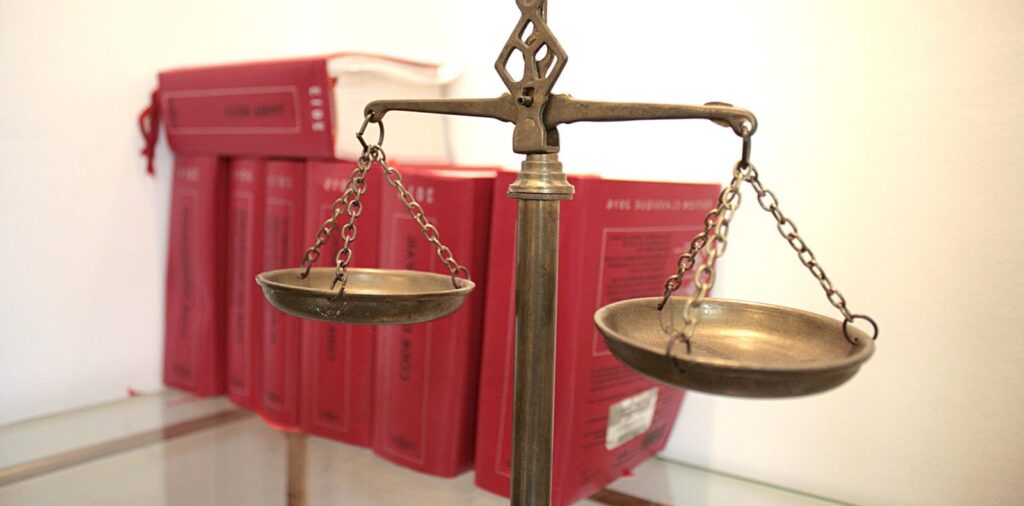The issue of who is the trustee of an EOT, can sometimes get a little diluted, when in fact the answer is quite simple.
But you need to delve beyond the initial answer to understand both the legalities of the matter and also who does what in an EOT.
Officially there is one trustee, informally there are more.
Confused? Let’s try and clear the situation up!
Who Is The Trustee Of An EOT?
Who Is The Trustee Of An EOT? The Legal Answer
An Employee Ownership Trust (EOT) is a trust established to own the shares in the trading company of a business.
It is there for the benefit of the business’s employees and legally controls the trading company.
When it comes to EOTs in the UK, legally the trustee will normally be a UK-based limited company, limited by guarantee rather than shares.
So in reality it is fairly simple.
Smith and Jones Builders Ltd become employee-owned. An EOT is set up to control it legally.
The EOT that is set up is controlled by its trustee, the UK-based Limited Company. It might be called Smith and Jones Builders EOT Ltd, legally this is the trustee of the EOT.
Who Is The Trustee Of An EOT? The Informal Answer

Where the confusion can arise is due to the fact that both the trading company and the EOT company have their own leadership.
- Smith and Jones Builders Ltd: Has a normal management structure with directors who control the day-to-day running of the company.
- Smith and Jones Builders EOT Ltd: Has its own set of directors. They do not get involved in the day-to-day running of the trading company but they are responsible for ensuring the trading company is well-led and progressing according to its goals and business plan, etc. Informally the directors of the EOT Ltd company are often referred to as ‘trustees’.
And that is where sometimes the waters get muddied.
So legally the trustee of an EOT is the limited company, in our example above that is Smith and Jones Builders EOT Ltd.
But informally the directors of Smith and Jones Builders EOT Ltd are referred to as trustees.
So from now on when we refer to trustees, we are referring to the directors of the EOT company!
So who are the trustees of an EOT and how are they chosen?
Let’s take a closer look.
How Are the Trustees of an EOT Chosen?

When an EOT is set up it is important that the trustees of the EOT represent both the employees of the trading company and have suitable expertise in company governance.
For this reason, the trustees of an EOT will usually fall into three groups:
- Employee Trustee: Someone who can represent the voice of the staff.
- Founder/Director Trustee: Usually either the founder of the business or someone to represent them, as they will have a detailed understanding of the company.
- Independent Trustee: A completely external voice, to ensure the interests of the founder/director and the staff are balanced.
Small employee-owned companies usually have three trustees, one from each of the groups above.
Larger companies will have more, but they will still tend to come from each of the three groups mentioned previously, just more than one person from each of the groups.
Let’s look at the trustees of an EOT in a bit more detail:
Employee Trustee
So as previously stated the employee trustee provides a voice for the staff in an EOT.
In smaller employee-owned companies there will usually just be one employee trustee, in large companies there might be more than one employee trustee or an Employee Council set up, with a representative from the Council sitting in the position of employee trustee.
In the case where there is a single-employee trustee, selecting the trustee is very important.
The employee trustee should represent the employees and therefore should be selected by the employees.
If the employee trustee is selected by the former owner, then there is the risk that fellow employees would not fully trust that they are representing their interests appropriately.
The employee trustee also should not be the person with the loudest voice, the process of selecting the employee trustee needs to be inclusive, so everyone has the opportunity to be heard.
It should also be remembered that there is a likelihood that the employee trustee will be in a position that is completely new to them.
Essentially they will be part of the EOT board that is holding the management of their employer, the trading company, to account.
So some initial training or guidance on what being a trustee of an EOT entails may be needed.
Founder/Director Trustee
To smooth the transition of ownership the founder of the business will often be a trustee or appoint a trustee to represent them.
As with the appointment of the employee trustee, this can have both its plusses and minuses.
The former owner will always have the best interest of the business they created at heart.
However they may find the transition to employee ownership difficult initially, especially if they are still being paid for the business from its profits, as often happens to begin with.
Additionally, if the previous owner remains in a position of power, some employees may feel that the owner is not giving up power at all and that their voice is not being effectively heard.
One solution to this is, if the business founder takes their place as a trustee, to set a finite time for them to be a trustee.
This could be a year, or until any deferred consideration is paid off. It should provide enough stability to ensure the trustees start in the right direction, but not too much for employees to think the founder is not giving up control.
Also worth bearing in mind that with three trustees, the employee trustee and independent trustee should always be able to outvote the founder trustee, ensuring that control does not continue to rest with the founder.
Independent Trustee

As the name suggests the independent trustee is there to provide a completely impartial voice.
They maintain a balance of perspectives so that neither the views and opinions of the selling shareholder, nor those of the employee are overrepresented.
The independent trustee should have a good breadth of business experience and also an understanding of legal duties, liabilities and responsibilities.
The independent trustee can also act as a mentor for the employee trustee, who may not have had previous experience of high-level business conversations, playing an important role in helping them understand and develop confidence in the area.
The employee trustee may also find it difficult to really say what they think to the founder trustee, who’s typically been there boss for many years (and outside of trustee meetings may still be their boss). The independent trustee can help bridge this gap, voicing any concerns the employees may have but be too scared to bring up.
Furthermore having an independent trustee as part of the EOT provides a level of reassurance to the employees that the former owner is not in control, and that their voices will be heard.
Final Thoughts
So let’s breakdown the answer to the question of who is the trustee of an EOT into two sections:
- Legally: The trustee of an EOT is normally a UK-based limited company, limited by guarantee rather than shares.
- Informally: The trustees of an EOT are the directors of the EOT company.
So usually when you hear people referring to the trustees of an EOT they are referring to the directors of the EOT trustee company.
They normally fall into three groups: an employee trustee, a founder/director trustee and an independent trustee.
Whichever answer to the question we take, the job of the EOT is always the same, to make certain the trading company is well-led, and to ensure the success of the EOT for its beneficiaries, the employees of the trading company.
